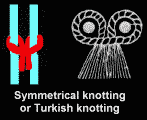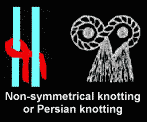At present, it is impossible to prove exactly when and where rug weaving began, as there is no reliable source, but it can be traced back as early the Neolithic age (7000 BC). The first examples consisting of warp and weft were textile products which resembled flat weave kilims. Then rugs were created by forming knots to make a pile. According to scientist, rug weaving must have originated in the dry steppe regions where the nomadic tribes lived. Central Asia was a suitable location for the first rug-weaving center because of the availability of land for herding sheep and because of the climate of the region.
Rugs have been used in the home as floor coverings, blankets, tablecloths and decorations. They acquire value as they are used, whereas most objects decrease in value over time. The oldest example known in the history of hand-make rugs is the one which is exhibited in the St. Petersburg Hermitage Museum in Russia. This fantastic Altai rug was discovered by the Russian archaeologist Sergei Rudenko in 1949 and is known as the "Pazirik Rug", woven around the 3rd century BC. The majority of experts believe that there is a link between ancient Turkish culture and this particular rug; they also believe that the other items found in the Pazirik Tumulus have some connection to Turkish civilization.
 Rug weaving in Anatolia first began with the arrival of the Turkish tribes from Central Asia, who settled in this region. Therefore, Anatolian rugs form a branch of ethnic Turkish rugs. Some of the oldest examples known are the eighteen surviving pieces woven by the Seljuk Turks in the 13th century. The motifs in these pieces represented in stylized floral and geometrical patterns in several basic colors and were woven in Sivas, Kayseri and Konya provinces.
Rug weaving in Anatolia first began with the arrival of the Turkish tribes from Central Asia, who settled in this region. Therefore, Anatolian rugs form a branch of ethnic Turkish rugs. Some of the oldest examples known are the eighteen surviving pieces woven by the Seljuk Turks in the 13th century. The motifs in these pieces represented in stylized floral and geometrical patterns in several basic colors and were woven in Sivas, Kayseri and Konya provinces.
The art of rug weaving which began with the Seljuks continued with the Ottomans. After the Seljuk Turks and before the Ottomans, during the transition period in the 14th century, animal figures began to appear on the rugs. Although very few of these exist today, they can be seen in the paintings of famous Italian, French and Dutch painters. Due to the animal figures on these rugs, they are called as "Rugs with Animals".
By the 15th century there was a wider variety of animal motifs on the rugs. A new group of rugs with a combination of animal motifs and geometrical patterns appeared around this time. These rugs were called "Holbein Rugs" since they appear in paintings by the German artist Hans Holbein. As there are no surviving examples of these rugs today, all research is carried out from the paintings. The works of artists such as Lotto, Memling, Carlo Crivelli, Rafaellino de Gardo, Bernard Van Orley, Carpaccio, Jaume Huguet were also important sources of research. In this century, Bergama and Usak became important weaving centers in western Anatolia.
The 16th century was the beginning of the second successful period of Anatolian rug-weaving. The rugs from this period are called "Classical Ottoman Rugs". The reason these rugs are called "Palace rugs" is that the design and colors would have been determined by the palace artists and then sent to the weaving centers. this method was similar to that used in the ceramic tile production of that period.
The designs, which consisted of twisting branches, leaves and flowers such as tulips, carnations and hyacinths, are woven in a naturalistic style and establish the basic composition of the rug. This style was continued in other regions and can be seen in Turkish rugs today.
In the 16th, 17th and 18th centuries, Gördes, Kula, Milas, Ladik, Mucur, Kirsehir, Bandirma and Canakkale gained importance as rug-weaving centers, along with Usak and Bergama. The rugs woven in some of these areas are known as "Transylvanian Rugs" because they were found in churches in Transylvania.
In the beginning of the 19th and 20th centuries, the rugs woven in Hereke (nearby Istanbul) gained worldwide recognition. These rugs were originally woven only for the Sultans of the Ottoman Empire. The finest silk rugs in the world are still being woven in Hereke today.
We can identify the rugs woven in different regions as town or village rugs. The rugs woven in the agricultural areas of Anatolia owe their origins to the settlers or nomadic cultures. In Europe, these rugs (which are woven with wool on wool) are generally called "Anatolian Rugs" In towns where people have settled permanently, the rugs are woven with a wool on cotton combination.
Today in Turkey there are regions which keep this wonderful tradition alive; such rugs are woven in Konya, Kayseri, Sivas, Hereke, Yagcioglu, Kula, Dösemealti, Taspinar, Isparta, Milas, Bergama, Canakkale, Kars, Usak, Gordes, Fethiye and Yahyali. There are different types of rugs produced in Turkey and they are classified according to the materials used:
- Silk on silk
- Wool on cotton
- Wool on wool
- Viscose on cotton
- Kilims
- Tulu
A rug is a handicraft which consist of two parts; the skeleton of the rug, which is formed by vertical and horizontal threads called "warps" and "wefts" and the part which resembles a picture and is like velvet, which is called the "pile" of the rug, made by knotting different colors of thread. In order to form motifs, there are two knotting techniques:


- Symmetrical knotting, double or Turkish knotting. Each knot is made on two warps. In this form of knotting, each end of the pile thread is wrapped all the way around the two warps, pulled down and cut.
- Non-symmetrical or single (Persian) knotting. While one end of the thread is wrapped all the way around the warp, the other end goes just beside the other warp. Then both ends are pulled down and cut.
The steps for weaving a carpet are written below:
- The weaving is started from the bottom of the loom. First the kilim part (flat woven part) is woven at the lower edge.
- The weaver then takes a piece of wool which corresponds with the pattern and forms a knot on two warps.
- Then she cuts the surplus wool with a knife.
- After one row of knotting is completed, she then passes a weft thread in between the front and back warps. The weft threads are used to strengthen the weaves of the carpet.
- Then she will take the "kirkit" (a heavy comb like tool) and vigorously beat down the row of knots and weft, in order to obtain the desired tightness and to make the knots and weft compact.
- Following this step, with a pair of adjustable scissors she cuts the surplus colored threads to obtain a uniform level of pile thickness.
- This process is continued until the carpet is complete.
Dyes
There are two types of dyes which are used to dye wool for weaving: vegetable dyes and chemical dyes. Rugs which are made using natural dyes are the most preferred. The natural dyes are obtained from three sources: plants; animals; and minerals. Plant sources are used most widely in rug production. Some of the examples of colors obtained from plants and animal sources are: red (RUBIA TINTORIA); yellow (GENISTA TINTORIA); navy blue (ISOTIS TINCTORIA and INDIGO FERETINTORIA); gray and black (OVER LUS); brown (JUNGLAND REGIA); and red (DACHYLOPIUS COCUS). Dyeing threads by using sources from nature is an art which has been practiced since ancient times. Anatolia has a large variety of plants available for dyeing purposes and this is where the craft of dyeing has been improved throughout centuries of experience. Plants gathered from natural sources are still widely used today.
Motifs
There are many different types of motifs and emblems which can be seen on the rugs. These are classified into two groups:
- Geometrical or Stylized Motifs
- Naturalistic and Floral Designs
The motif on the rugs represent Anatolia and Central Asia and their civilizations. These compositions, motifs, and designs represent the origins and culture of a society; therefore, a rug can be considered a cultural item. Each of the designs is meaningful, not an accidental drawing. To understand the meaning of every motif would be a very long and tiring process, as there are so many of them which have accumulated throughout the centuries. The motifs on the rugs represent Anatolia, Central Asia and their civilizations. Some of the most common motifs on rugs are the TREE OF LIFE symbolizing long life and re-birth; the HORNS OF ANIMALS which symbolize power; HANDS ON HIPS symbolizing female fertility and the mother of God; and the HANGING CANDLE symbolizing the holy (eternal) light.

